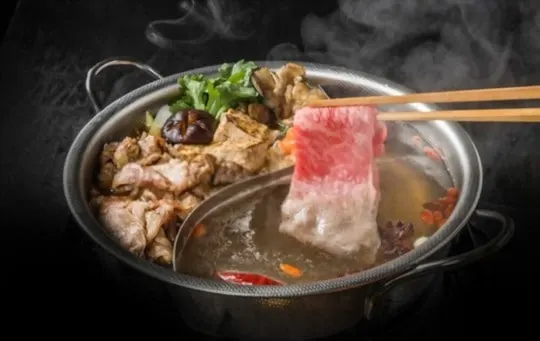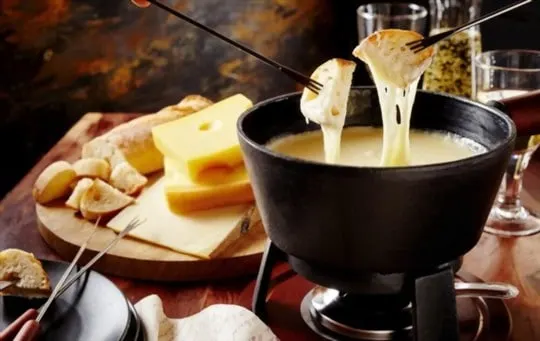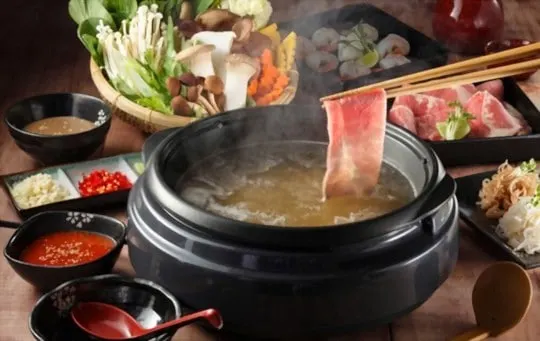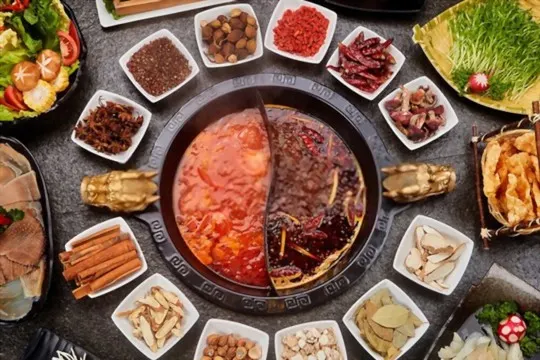Hot Pot or Fondue? That’s the question.
Both star in our meals when the weather screams for comfort food. Hot Pot, a feast where you swim your food in a simmering pot of broth. Fondue, on the other hand, is the creamy dream where bread and veggies get a cheese or chocolate dip.
We’ve all been there. The chilly evening with friends, debating if we should dunk bread in cheese or cook thinly sliced meat in broth. Hot Pot offers a spicy dance, while Fondue brings a smooth waltz.
Our nights have seen both. Sometimes together, because why not? Mixing traditions, laughing over spilled broth, and double-dipping rules. It’s not just about food; it’s about what these meals create.

What is Hot Pot?

Hot Pot is a Chinese delicacy that is gaining popularity worldwide.
It is also known as “Chinese fondue” or “steamboat” and involves cooking raw ingredients in a pot of simmering broth at the center of the dining table.
The ingredients include meat, seafood, vegetables, tofu, noodles and various dipping sauces.
It’s a great way to bond with friends and family while enjoying a warm and comforting meal.
Hot Pot has many variations depending on the region of China and personal preferences.
The most popular types are Sichuan spicy hot pot, Cantonese clear broth hot pot, and Mongolian hot pot with lamb.
Hot Pot can be enjoyed at home or in restaurants offering an all-you-can-eat buffet.
One unique aspect of Hot Pot is the communal aspect where everyone cooks their food in the same broth, sharing utensils and dipping sauces.
This emphasizes the socializing aspect of eating together while providing endless possibilities for flavor combinations.
Overall, Hot Pot is a delicious and fun way to enjoy a meal with loved ones while experimenting with different flavors and ingredients.
What is Fondue?

Fondue is a European culinary tradition that involves cooking food in a communal pot of hot liquid, usually cheese or chocolate.
Various types of meats, vegetables, and bread are dipped into the liquid using long forks.
The pot is placed over low heat to keep the contents warm.
Fondue is commonly served as an appetizer or as a main course.
Many variations of fondue exist, with cheese and chocolate being the most popular ones.
Cheese fondue typically consists of melted cheese, wine, spices and garlic while chocolate fondue includes melted chocolate mixed with cream and various flavorings such as vanilla extract and liqueurs.
The communal aspect of fondue makes it a popular choice for dinner parties or casual get-togethers.
It encourages socialization while providing a delicious and interactive dining experience for everyone involved.
In comparison to hot pot, fondue offers a more indulgent and decadent option.
While both dishes involve communal cooking and shared meals, fondue tends to be reserved for special occasions due to its richness and higher price point.
Overall, choosing between hot pot vs fondue depends on personal preference and occasion.
Key Differences Between Hot Pot and Fondue

Hot pot and fondue are both traditional hot dishes that are enjoyed by people all over the world.
These dishes have unique features, and it is important to note the differences between them.
- Hot pot is an Asian dish where raw ingredients such as meat and vegetables are cooked in a communal pot of simmering broth. On the other hand, fondue is a Swiss dish that involves dipping bread or vegetables into a communal pot of melted cheese or chocolate.
- Hot pot typically involves cooking ingredients in a spiced broth which gives the food a distinct savory flavor. Fondue, on the other hand, has a much sweeter taste due to the melted cheese or chocolate.
Lastly, hot pot is often served with dipping sauces that complement the spiciness of the broth, whereas fondue usually does not involve dipping sauces.
Cooking Method
Using various cooking methods can make meals more enjoyable.
The hot pot and fondue are two of the most popular cooking techniques today.
Both methods involve submerging ingredients in a pot of boiling liquid or oil.
Hot pots use soup broth while Fondue involves melted cheese, chocolate, or hot oil.
While both Hot Pot and Fondue can be enjoyed with family & friends, there are noticeable differences between the two cooking styles.
The main difference between these methods is the type of food that they go best with based on cultural cuisine preferences and taste.
Chinese cuisine prefers using Hot Pot for savory dishes such as meatballs, vegetables, noodles – while Swiss prefer using Fondue for sweet & savory snacks such as fruits, veggies, bread.
Ingredients and Dishes Served
This article discusses the diverse ingredients and dishes that are on offer when enjoying either hot pot or fondue.
These communal meals have variations in cuisine, with Chinese and Swiss influence respectively.
Both dishes typically involve cooking raw weal at one’s table in a simmering broth or delicious cheese blend.
While both accompaniments come in a variety of presentations, the broth involved in hot pot is typically spicier than the dip used for fondue.
Flavor and Taste Experience
The gastronomic experience is a crucial aspect when it comes to deciding upon Hot Pot or Fondue.
Both dishes are known for their unique flavor profile, and it solely depends on one’s preference.
The flavor palette of hot pot could range from mild and savory to bold and spicy, whereas fondue typically comprises rich, cheesy flavors that are often paired with bread.
Ultimately, the choice between the two dishes boils down to personal taste.
Hot pot offers a wild firework of seasonings and spices that vary by region, preference, and ingredients.
With an endless array of vegetables, meats, seafood options available for dunking into the simmering broth, one can customize their palate adventure according to individual preferences.
In contrast, Fondue is based on cheese or chocolate melted at low temperatures along with bread on long forks.
The consistency of creamy melted cheese provides a profound indulgence which proves hard to resist.
When it comes to indulging into wild culinary experiences, neither Hot Pot nor Fondue disappoints.
The richness in taste coupled with customization options makes both dishes stand out in their way.
It is worth mentioning that while hot pots may be too spicy or flavorful for some pallets while fondue is less versatile than hot pot as it mainly focuses on cheese or chocolate profiles only.
Ultimately both dishes provide unique occasions for gathering with friends and family over a hearty meal that is creatively satisfying while invoking nostalgia from your taste buds’ memory lane.
Cultural Origins and Traditions
Hot Pot and Fondue are both culinary traditions that have been around for centuries.
While their origins may differ, they share similar cultural significance as communal meals best enjoyed with family and friends.
Hot Pot, commonly referred to as “Huoguo” in China, has its roots in Mongolian nomadic cuisine.
It is a staple family-style dish that features a simmering pot of broth served alongside an assortment of thinly-sliced meats, vegetables and seafood, cooked at the table.
On the other hand, Fondue hails from Switzerland and was traditionally consumed by rural Alpine communities during winter months.
This dish involves melting cheese or chocolate in a communal pot before diners dip bread or fruits into it using long-stemmed forks.
Both of these dishes offer a unique dining experience that brings people together over a shared love for food.
However, Hot Pot tends to be more versatile as there are endless broth options to cater to different preferences while Fondue has limited variations.
Similarities Between Hot Pot and Fondue
Hot Pot and Fondue are both communal cooking experiences where food is cooked and shared among the diners.
The two cuisines have similarities in terms of cooking equipment, fresh ingredients and dining format.
Both use a central pot or vessel to cook raw ingredients while diners gather around it to enjoy the meal together.
Furthermore, Hot Pot and Fondue offer a wide range of ingredient options such as meats, seafood, vegetables, noodles, and dipping sauces to enhance the flavor of the dish.
This creates a customizable dining experience for everyone at the table.
Additionally, both cuisines provide a cozy and intimate atmosphere that encourages interactions between diners.
It allows them to share their cooking skills and exchange cultural influences while enjoying their food.
In summary, despite having different origins, Hot Pot and Fondue have many commonalities that make them excellent choices for social gatherings or special occasions.
Factors to Consider in Choosing Between Hot Pot and Fondue

When deciding between hot pot and fondue, several factors must be taken into account.
One should consider the desired dining experience, cultural preferences, availability of ingredients, type and quantity of cooking equipment, budget, and safety measures.
Additionally, one must decide whether to opt for a communal meal or single-service cookware.
Another factor to consider is the level of interaction between diners.
Hot pot provides an atmosphere conducive to group dining and conversation as everyone can share ingredients in a large pot.
On the other hand, fondue allows for customized portions and individual dipping sauces but may not be as conducive to socializing.
Finally, it is important to prioritize safety measures when serving hot pot or fondue.
Ensure that the heating apparatus is stable and appropriate for the chosen cooking method and that all participants are familiar with proper food handling procedures.
Overall, both hot pot and fondue have their unique advantages and considerations when choosing a dining option.
Ultimately, the decision should be made based on personal preferences and priorities in regards to taste, communal dining, equipment availability, budget, safety measures etc.
Group Size and Social Dining
Group dining experiences and the number of attendees play a crucial role in deciding between hot pot and fondue.
These two social eating methods differ significantly and cater to different group sizes and preferences.
- Hot Pot: Ideal for large groups of people who prefer a customized experience. Offers various broth options, meat cuts, dipping sauces, and ingredient combinations ideal for large groups’ diverse dietary requirements. Requires frequent supervision to avoid overcooking or undercooked meats due to longer cooking times for each ingredient when catering to significant table sizes.
- Fondue: Better suited for small gatherings with fewer participants, who enjoy the traditional communal dining style. Limited options, with cheese or chocolate dips, bread or fruits as sides, making it easier to serve smaller parties. Easy-to-use; it involves dipping bread cubes into the melting cheese mix or using forks to dip fruit in hot chocolate – no active involvement required post-set up.
For larger groups that desire an interactive culinary adventure with personalized options suited to different diets, hot pot may be the better option.
In contrast, smaller gatherings with simpler requirements may prefer fondue’s traditional communality aspects.
Ultimately, it comes down to group size and their preference of culinary experiences as there is no single determination factor between the two.
Preference for Cooking Style
For those who love cooking and dining with friends and family, choosing a suitable cooking style is essential for an enjoyable culinary experience.
Various factors such as taste, convenience, and cultural preference may affect individual preferences for cooking styles.
When it comes to hot pot and fondue, both are popular choices for communal feasting.
Hot pot involves dipping raw ingredients into a bubbling pot of soup broth placed on the table while fondue requires food to be dipped in melted cheese or chocolate.
While hot pot is more common among Asian cultures, fondue originated from Swiss cuisine.
One factor that affects the preference between these two styles is taste.
Hot pot allows for a wider variety of ingredients to be used, including meats, seafood, vegetables and noodles which can be tailored to individual tastes.
Whereas fondue has a limited range of ingredients that mainly involves bread cubes or sliced fruits.
Another factor worth considering is convenience during preparation and consumption.
Hot pot typically requires more time and effort to prepare due to the need for simmering soup broth and slicing ingredients beforehand.
In comparison, fondue set up is relatively easy as it only requires melting cheese or chocolate in a pot which can be easily carried around if required.
To sum up, the choice between hot pot versus fondue ultimately depends on personal preference regarding taste, culture and convenience.
Dietary Restrictions and Preferences
For people with specific dietary restrictions and preferences, choosing a suitable meal can be quite challenging.
The decision to opt for hot pot or fondue depends on the dietary needs of the individuals involved.
Hot pot offers a broader range of options such as vegetables, meat, seafood and tofu making it a perfect choice for vegetarians, pescatarians and meat lovers.
Fondue provides protein sources like cheese and meats which are great for non-vegetarian individuals but people who avoid dairy would have to exclude fondue from their list of food choices.
It is crucial to note that some people may have specific allergies or intolerances which could make either of the options a poor fit.
Consulting with the restaurant staff about ingredients used in each dish is essential before making a final decision on whether or not a hot pot or fondue is suitable.
Considering individual requirements, dietary restrictions and preferences play an imperative role in determining whether hot pot or fondue is a better option.
Therefore, it’s necessary to ensure that everyone’s dietary needs are met before deciding on what type of meal you choose.
Conclusion
Comparing hot pot and fondue reveals that both are delectable options for communal dining experiences.
Each dish offers unique flavors and presentation styles, making it difficult to declare a clear winner between the two.
Hot pot’s broth-based cooking style provides a healthy option with endless ingredient combinations while fondue’s melted cheese offers rich and indulgent flavor.
Ultimately, the choice between hot pot or fondue comes down to personal preference and the occasion.
Whether you’re seeking a cozy night in or a festive gathering, both dishes are sure to impress and satisfy.

Hot Pot vs Fondue: Which is a Better Option?
Ingredients
- Hot Pot
- Fondue
Instructions
- Choose between a hot pot and fondue based on your preference and desired dining experience.
- Follow the cooking instructions specific to your chosen method, whether it's preparing broth for hot pot or melting cheese for fondue.
- Prepare your ingredients accordingly, ensuring they are suitable for cooking in the hot pot or dipping in fondue.
- Heat the hot pot or fondue pot according to the appliance's instructions, maintaining the desired temperature.
- Cook your ingredients in the hot pot broth or dip them into the melted fondue, ensuring they are fully cooked or coated.
- Enjoy the interactive dining experience of cooking and sharing food with others.
- Explore different flavors and ingredients, experimenting with various combinations to enhance your hot pot or fondue experience.
- Remember to follow proper safety guidelines and enjoy your delicious hot pot or fondue creations with friends and family.

Andrew Gray is a seasoned food writer and blogger with a wealth of experience in the restaurant and catering industries. With a passion for all things delicious, Andrew has honed his culinary expertise through his work as a personal chef and caterer.
His love for food led him to venture into food writing, where he has contributed to various online publications, sharing his knowledge and insights on the culinary world. As the proud owner of AmericasRestaurant.com, Andrew covers a wide range of topics, including recipes, restaurant reviews, product recommendations, and culinary tips.
Through his website, he aims to inspire and educate fellow food enthusiasts, offering a comprehensive resource for all things food-related.

Leave a comment